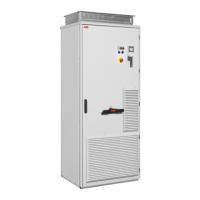50 Guidelines for planning the electrical installation
Protecting the motor insulation and bearings
The drive employs modern IGBT inverter technology. Regardless of frequency, the drive
output comprises pulses of approximately the drive DC bus voltage with a very short rise
time. The pulse voltage can almost double at the motor terminals, depending on the
attenuation and reflection properties of the motor cable and the terminals. This can cause
additional stress on the motor and motor cable insulation.
Modern variable speed drives with their fast rising voltage pulses and high switching
frequencies can generate current pulses that flow through the motor bearings. This can
gradually erode the bearing races and rolling elements.
Optional du/dt filters protect motor insulation system and reduce bearing currents.
Optional common mode filters mainly reduce bearing currents. Insulated N-end (non-drive
end) bearings protect the motor bearings.
Examining the compatibility of the motor and drive
Use an asynchronous AC induction motor, permanent magnet synchronous motor, AC
induction servomotor or ABB synchronous reluctance motor (SynRM motor) with the drive.
Several induction motors can be connected to the drive at a time.
Select the motor size and drive type from to the rating tables in chapter Technical data on
basis of the AC line voltage and motor load. Use the DriveSize PC tool if you need to tune
the selection more in detail.
Make sure that the motor withstands the maximum peak voltage in the motor terminals.
This voltage can typically be twice the DC link voltage (U
DC
) of the drive:
Note: The voltage peaks at the motor terminals are relative to the supply voltage of the
drive, not the drive output voltage.
Note: Consult the motor manufacturer before using a motor whose nominal voltage differs
from the AC line voltage connected to the drive input.
U
DC
1.35 · 1.25 · 415 V DC (when supply voltage is 380 to 415 V AC)
1.35 · 1.25 · 500 V DC (when supply voltage is 440 to 500 V AC) or

